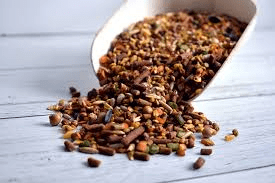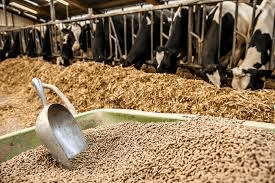The following are the guidelines to proper animal feed storage and the methods available;
1. Store all feed and ingredients at a cool temperature (ideally below 77° F although this is not possible at outside locations under summer conditions).
2. Keep feed dry to prevent fungal or bacterial growth.
3. Prevent rodent or insect entry into feed.
4. Use antioxidants to preserve fats and oils in ingredients and feed.
5. Use stable forms of vitamins.
6. Expiration dates (usually on container) are required for all food items.
- Known shelf life of some products is marked on container (e.g., canned food).
- Prepared feeds: one week after end of experiment or 8 weeks post mixing (whichever is shorter).
- Ground grain: One month after milling unless stabilized.
- Fats and oils:
- Opened container: One month
- Un-opened or stabilized: One year post mixing.
- Vitamin mixtures: 6 months after preparation (exceptions of up to one year if stabilized with ethoxyquin). Vitamin C hydrolyzes more rapidly.
- Whole grain or seeds: One year after harvest
- Fat-free ingredients, protein meals, minerals: No specific expiration dates as long as feeds remain dry and free from obvious contaminants (These items should carry an acquisition date.
Justification
Captive animals depend on caretakers for a diet that supplies adequate amounts of nutrients required for good health. Some nutrients are subject to destruction by chemical action or light.
Moisture, heat, and, in some cases, light accelerate destruction of nutrients in feed ingredients. Proper preparation of feeds and appropriate storage conditions can prolong the shelf-life of feeds and ingredients, but not indefinitely.
Read Also: Proper Methods of Storage and Handling of Animal Feedstuffs
Therefore, all containers of feed and most ingredients must have an accepted expiration date. Feed should be discarded on or before this date.
Guide to Ensure Prevention or Reduction of Damage to Animal Feed and Ingredients

1. Grains and Grain Products
Obtain clean, insect-free grain (or treat grain with a USDA-approved insecticide). Have an effective, safe rodent control program in place.
Store feed in a cool, dry location, free from conditions where condensate may form.
Store large quantities of feed in tight paper containers or in ventilated cloth or papersacks or in bulk. These containers allow moisture to migrate and escape rather than condense, which allows mold growth.
Smaller quantities of feed, as present in feed mixing rooms, should be stored in closed plastic containers to prevent entry of insects, rodents, and moisture. The initial moisture content of the feed should be less than 14 %.
Grind corn and other grains shortly before use. Grinding, flaking, or crimping releases the oil in the germ of the seed. This oil contains polyunsaturated fats and a limited amount of natural antioxidants. Therefore, rancidity will occur within days or weeks after grinding.
2. Protein Sources
Low-fat (<1%), dry (<12 % moisture) protein sources (e.g., casein, isolated soy protein, solvent extracted meals of soybean, peanut, etc., may be kept indefinitely). However, they should be labeled with an acquisition date.
Meals with fat, usually > 2% ( e.g., cottonseed meal , sunflower seed meal, meat meals, meat and bone meals, poultry meals, fish meal) have a limited shelf life that may be extended to about 6 months if an appropriate antioxidant (e.g., ethoxyquin, TBHQ, BHA-BHT) has been added.
These meals should be stored in a cool location ( ideally<77° F, although this may not be possible under summer conditions at the field labs). In summer, use these ingredients within 2 months of milling.
Whole seeds (soybeans, cottonseed, sunflower, etc.) will keep for at least one year in a cool location. Their oil is contained in oil glands along with a natural antioxidant.
3. Fats and Oils
Unopened containers of vegetable oil should keep for one year only. However, once opened and exposed to air, the oil begins to oxidize.
The oil may be stabilized by adding ethoxyquin (Santoquin from Novus, Inc., St. Louis, MO), or TBHQ (Eastman Organic Chemicals) at levels such that the total amount of these preservatives in the final feed does not exceed 0.0125% of the diet (125 mg//kg
Read Also: Classification of Animal Feedstuffs
4. Mixed Feeds

The moisture content of feed should be <12%. Store feed in closed bags in a cool dry place. Prevent rodent and insect exposure.
Add an antioxidant to the feed (or with the added fat) at time of preparation
If no antioxidant is added, store feed in a cool location for a limited period of time.
If glucose monohydrate (dextrose, cellulose) is used as a feed ingredient, consider that glucose will react with the free amino groups of protein and added amino acids within hours to days.
Vitamin C (ascorbic acid) is stable for only days, not weeks. Ascorbic acid phosphate is a commercially available, stable form of vitamin C. It is required in diets for primates, guinea pigs, fish, and probably lizards and some other types of animals.
Add vitamin premixes to diets to provide all the vitamins at concentrations 4 to 5 times required level stated in the National Research Council publications on nutrient requirements of Animals (Government Printing Office, Constitution Ave., Washington, DC), except when the experimental protocol requires otherwise.
5. Vitamin and Mineral Premixes
Vitamin premixes usually contain some ethoxyquin, and the vitamins A and E are added as the stable acetate derivatives.
Vitamin C is usually not added to vitamin premixes but rather is added separately just before mixing. However, ascorbic acid phosphate is a stable form of vitamin C, albeit more expensive.
DO NOT MIX VITAMINS AND MINERALS TOGETHER IN A PREMIX! This is done by some commercial mills, even done successfully using special preparations, but it is not a good, general recommendation.
Management Concerns in Handing Animal Feedstuffs

Animal feed handling, storage, and delivery equipment must be maintained and kept clean for proper feed use and animal safety.
Feed may cake and mold along the walls of bulk storage bins and feeders. Long-term feed storage or storage under less than ideal conditions may cause spoiled feed.
Rusty or corroded feeders may have sharp edges that are dangerous to livestock. Wooden feeders may have hazards such as broken boards or protruding nails. Thorough equipment cleaning requires more than just emptying the containers prior to refilling.
It often means scraping and rinsing equipment interiors. Repair and maintain equipment routinely. Patch holes to protect feedstuffs from rain, wind, rodent, bird, and insect damage and to limit feed waste.
Metal feeders may need rust protection and paint applications. Before beginning a new feeding regime, take time to evaluate the capability of the facilities at hand. The nutritional value of the feedstuff is important, but it is not the only factor in proper livestock feeding.
If bins, equipment, or feeders are in disrepair and feeds cannot be stored, handled, and delivered properly, the nutritional needs of livestock may not be met.
Making optimal use of feedstuff helps ensure that the feeding system is safe and economical. For more information on livestock feed handling, storage, or feeding or related topics, contact your local MSU Extension office.
Read Also: How to Produce Bar Soap Using Cold Method

